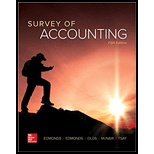
Alonzo Saunders owns a small training services company that is experiencing growing pains. The company has grown rapidly by offering liberal credit terms to its customers. Although his competitors require payment for services within 30 days, Saunders permits his customers to delay payment for up to 90 days. Saunders’s customers thereby have time to fully evaluate the training that employees receive before they must pay for that training. Saunders guarantees satisfaction. If a customer is unhappy, the customer does not have to pay. Saunders works with reputable companies, provides top-quality training, and rarely encounters dissatisfied customers.
The long collection period, however, has created a cash flow problem. Saunders has a $100,000
On the day Saunders was to execute the loan agreement, he heard a rumor that his biggest customer was experiencing financial problems and might declare bankruptcy. The customer owed Saunders $45,000. Saunders promptly called the customer’s chief accountant and learned “off the record” that the rumor was true. The accountant told Saunders that the company’s net worth was negative and most of its assets were pledged as collateral for bank loans. In his opinion, Saunders was unlikely to collect the balance due. Saunders’s immediate concern was the impact the circumstances would have on his loan agreement with the bank.
Saunders uses the direct write-off method to recognize uncollectible accounts expense. Removing the $45,000 receivable from the collateral pool would leave only $55,000 of receivables, reducing the available credit to $38,500 ($55,000 × 0.70). Even worse, recognizing the uncollectible accounts expense would so adversely affect his income statement that the bank might further reduce the available credit by reducing the percentage of receivables allowed under the loan agreement. Saunders will have to attest to the quality of the receivables at the date of the loan but reasons that since the information he obtained about the possible bankruptcy was “off the record” he is under no obligation to recognize the uncollectible accounts expense until the receivable is officially uncollectible.
Required
- a. How are income and assets affected by the decision not to act on the bankruptcy information?
- b. Review the AICPA’s Articles of Professional Conduct (see Chapter 4) and comment on any of the standards that would be violated by the actions Saunders is contemplating.
- c. How do the elements of the fraud triangle (see Chapter 4) apply to this case?
Want to see the full answer?
Check out a sample textbook solution
Chapter 5 Solutions
SURVEY OF ACCOUNTING(LL)>CUSTOM PKG.<
- Dennis Green and Peter Olinto are equal partners in Foxy PartneDennis Green and Peter Olinto are equal partners in Foxy Partnership. Peter is an active general partner. Dennis is a limited partner and is not involved in the operations of the business. Foxy Partnership's Year 2 financial statements are provided in the exhibits. Using the information provided, enter the appropriate amounts to be reported on page 1 of Foxy Partnership's income tax return in the table below. Enter all amounts as positive whole values. If a response is zero, enter a zero (0). 2. Cost of goods sold 3. Salaries and wages 4. Guaranteed payments to partners 5. Repairs and maintenance 6. Bad debts 7. Rent 8. Depreciation 9. Other deductions 10. Ordinary business income (loss)arrow_forwardIf a business pays off a loan, which of the following will occur?A. Assets and liabilities increaseB. Assets and liabilities decreaseC. Only liabilities increaseD. Equity decreasesarrow_forwardWhich financial statement lists revenues and expenses?A. Balance SheetB. Cash Flow StatementC. Income StatementD. Retained Earnings Statementneedarrow_forward
- No chatgpt! Which financial statement lists revenues and expenses?A. Balance SheetB. Cash Flow StatementC. Income StatementD. Retained Earnings Statementarrow_forwardWhich financial statement lists revenues and expenses?A. Balance SheetB. Cash Flow StatementC. Income StatementD. Retained Earnings StatementNo Aiarrow_forwardWhich financial statement lists revenues and expenses?A. Balance SheetB. Cash Flow StatementC. Income StatementD. Retained Earnings Statementarrow_forward
- Which account is a contra-asset?A. Accounts PayableB. Accumulated DepreciationC. Notes ReceivableD. Prepaid Rentcorrectarrow_forwardWhich account is a contra-asset?A. Accounts PayableB. Accumulated DepreciationC. Notes ReceivableD. Prepaid Rentcorrect solutuarrow_forwardWhich account is a contra-asset?A. Accounts PayableB. Accumulated DepreciationC. Notes ReceivableD. Prepaid Rentneedarrow_forward
- Which account is a contra-asset?A. Accounts PayableB. Accumulated DepreciationC. Notes ReceivableD. Prepaid Rentarrow_forwardChoose the items of income or expense that belong in the described areas of Form 1120, Schedule M-1 (Sections: Income subject to tax not recorded on books, Expenses recorded on books this year not deducted on this return, Income recorded on books this year not included on this return, and Deductions on this return not charged against book income.) Note the appropriate amount for the item selected under each section. If the amount decreases taxable income relative to book income, provide the amount as a negative number. If the amount increases taxable income relative to book income, provide the amount as a positive number. The following adjusted revenue and expense accounts appeared in the accounting records of Pashi, Inc., an accrual basis taxpayer, for the year ended December 31, Year 2. Revenues Net sales $3,000,000 Interest 18,000 Gains on sales of stock 5,000 Key-man life insurance proceeds 100,000 Subtotal $3,123,000 Costs and Expenses Cost of…arrow_forwardPlease provide the accurate answer to this general accounting problem using valid techniques.arrow_forward
 Individual Income TaxesAccountingISBN:9780357109731Author:HoffmanPublisher:CENGAGE LEARNING - CONSIGNMENT
Individual Income TaxesAccountingISBN:9780357109731Author:HoffmanPublisher:CENGAGE LEARNING - CONSIGNMENT



